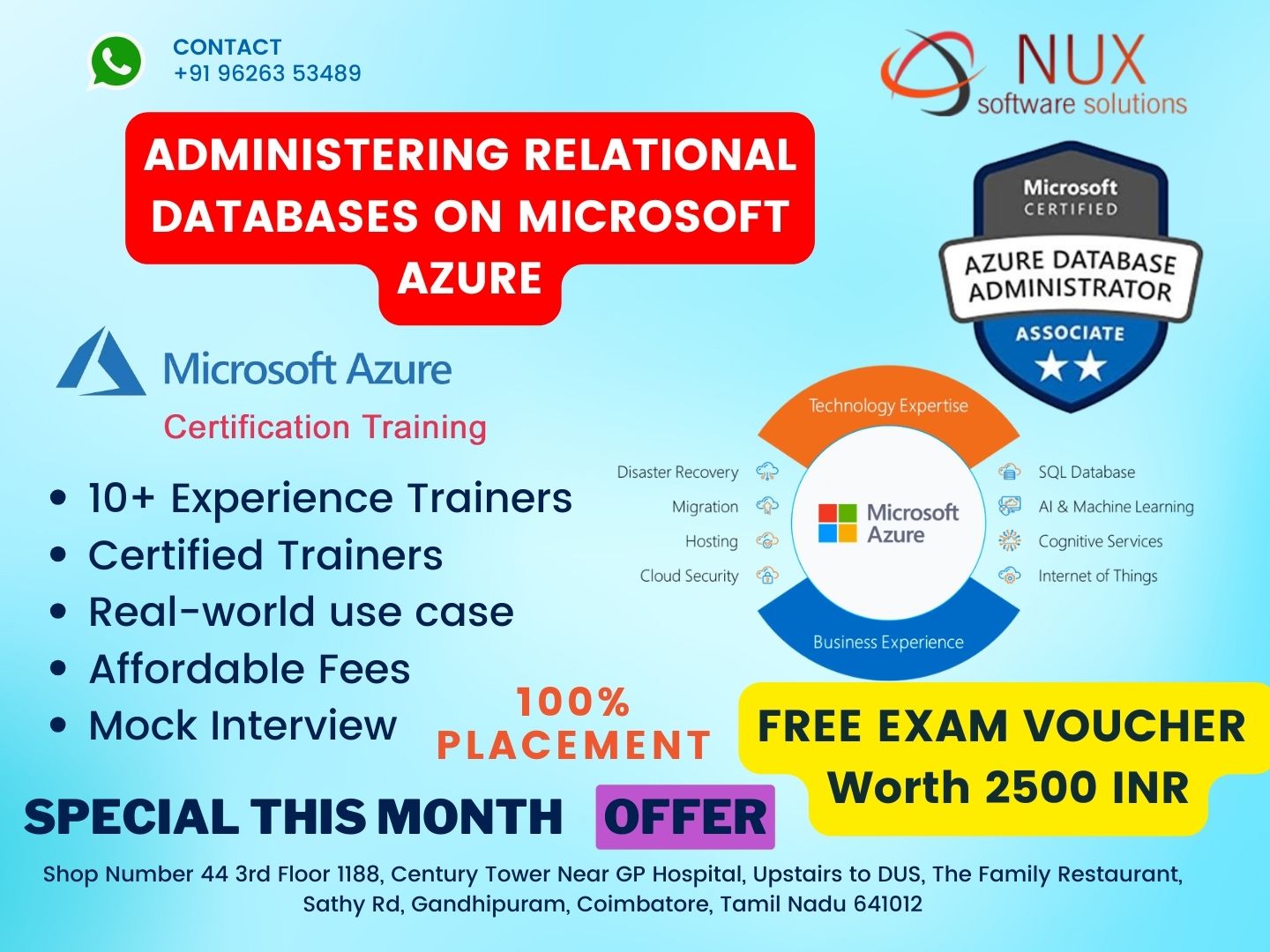Administering Relational Databases on Microsoft Azure – DP-300

DP-300: Administering Relational Databases on Microsoft Azure Training in Coimbatore
Course Overview
The DP-300 certification course, Administering Relational Databases on Microsoft Azure, is designed for database professionals who want to manage, monitor, and secure SQL Server and Azure SQL databases in cloud and hybrid environments. This course provides comprehensive training on administering both platform-as-a-service (PaaS) and infrastructure-as-a-service (IaaS) database solutions on Microsoft Azure.
At Linux Training Center in Coimbatore, we offer instructor-led, hands-on training that prepares you for the official DP-300 exam and helps you become a certified Microsoft Azure Database Administrator Associate.
Why Learn DP-300?
As businesses continue migrating to the cloud, the demand for skilled Azure database administrators is soaring. This course equips you with essential skills in deploying and managing cloud-based databases, automating database tasks, and ensuring high availability and disaster recovery in enterprise environments.
DP-300 certification demonstrates your ability to optimize database performance, implement security measures, and troubleshoot issues across various Azure database offerings.
Who Should Enroll?
This course is ideal for database administrators, database developers, IT professionals, and cloud administrators looking to specialize in Azure-based database solutions. It’s also recommended for candidates planning to take the DP-300 certification exam and earn the Azure Database Administrator Associate credential.
Prior experience with SQL Server or any relational database is helpful but not mandatory.
What You Will Learn
You’ll gain hands-on experience with deploying Azure SQL Databases, configuring backup and restore strategies, automating tasks with PowerShell and Azure CLI, managing database security, and tuning performance for cloud workloads.
Topics also include monitoring database health, scaling database resources, implementing auditing, encryption, and threat protection, and using tools like Azure Monitor and Query Performance Insight.
Training Features
100% syllabus coverage aligned with Microsoft DP-300 exam
Real-time labs on Azure SQL and SQL Server on VMs
Guided projects and database automation exercises
Live training by Microsoft-certified instructors
Mock exams, study guides, and career assistance
Flexible schedules with weekend and weekday batches
Career Opportunities
After completing this course, you’ll be ready for roles such as Azure Database Administrator, Cloud DBA, Database Reliability Engineer, SQL Server Admin, and Database Consultant. The DP-300 certification is recognized globally and can significantly boost your career in cloud data management.
Why Choose Linux Training Center?
We offer practical, career-focused training programs with expert mentorship and lab infrastructure designed to give you real-world experience. Our trainers bring industry knowledge and certification support to ensure your success in both the exam and the workplace.
Advance your career in cloud data administration with the DP-300 training at Linux Training Center, Coimbatore. Learn to deploy, secure, and optimize Azure-based databases and become a certified Azure Database Administrator. Enroll now or contact us to schedule your class.
DP-300 Course Syllabus
Modules
Plan and Implement Data Platform Resources (20-25%)
Plan and deploy Azure SQL solutions - Deploy database offerings on selected platforms- Understand automated deployment
- Apply patches and updates for hybrid and infrastructure as a service (IaaS) deployment
- Deploy hybrid SQL Server solutions
- Recommend an appropriate database offering based on specific requirements
- Evaluate the security aspects of the possible database offering
- Recommend a table partitioning solution
- Recommend a database sharding solution Configure resources for scale and performance - Configure Azure SQL Database for scale and performance
- Configure Azure SQL Managed Instance for scale and performance
- Configure SQL Server on Azure Virtual Machines for scale and performance
- Configure table partitioning
- Configure data compression Plan and implement a migration strategy - Evaluate requirements for the migration
- Evaluate offline or online migration strategies
- Implement an online migration strategy
- Implement an offline migration strategy
- Perform post migration validations
- Troubleshoot a migration
- Set up SQL Data Sync for Azure
- Implement a migration to Azure
- Implement a migration between Azure SQL services
Implement a Secure Environment (15-20%)
Configure database authentication and authorization - Configure authentication by using Active Directory and Microsoft Entra ID- Create users from Microsoft Entra identities
- Configure security principals
- Configure database and object-level permissions using graphical tools
- Apply the principle of least privilege for all securables
- Troubleshoot authentication and authorization issues
- Manage authentication and authorization by using T-SQL Implement security for data at rest and data in transit - Implement Transparent Data Encryption (TDE)
- Implement object-level encryption
- Configure server- and database-level firewall rules
- Implement Always Encrypted
- Configure secure access
- Configure Transport Layer Security (TLS) Implement compliance controls for sensitive data - Apply a data classification strategy
- Configure server and database audits
- Implement data change tracking
- Implement dynamic data masking
- Manage database resources by using Azure Purview
- Implement database ledger in Azure SQL
- Implement row-level security
- Configure Microsoft Defender for SQL
Monitor, configure, and optimize database Resources (20-25%)
Monitor resource activity and performance - Prepare an operational performance baseline- Determine sources for performance metrics
- Interpret performance metrics
- Configure and monitor activity and performance
- Monitor by using SQL Insights
- Monitor by using Extended Events Monitor and optimize query performance - Configure Query Store
- Monitor by using Query Store
- Identify sessions that cause blocking
- Identify performance issues using dynamic management views (DMVs)
- Identify and implement index changes for queries
- Recommend query construct modifications based on resource usage
- Assess the use of query hints for query performance
- Review execution plans
- Monitor by using Intelligent Insights Configure database solutions for optimal performance - Implement index maintenance tasks
- Implement statistics maintenance tasks
- Implement database integrity checks
- Configure database automatic tuning
- Configure server settings for performance
- Configure Resource Governor for performance
- Implement database-scoped configuration
- Configure compute and storage resources for scaling
- Configure intelligent query processing (IQP)
Configure and manage automation of tasks (15-20%)
Create and manage SQL Server Agent jobs - Manage schedules for regular maintenance jobs- Configure job alerts and notifications
- Troubleshoot SQL Server Agent jobs Automate deployment of database resources - Automate deployment by using Azure Resource Manager templates (ARM templates) and Bicep
- Automate deployment by using PowerShell
- Automate deployment by using Azure CLI
- Monitor and troubleshoot deployments Create and manage database tasks in Azure - Create and configure elastic jobs
- Create and configure database tasks by using automation
- Configure alerts and notifications on database tasks
- Troubleshoot automated database tasks
Plan and configure a high availability and disaster recovery (HA/DR) environment (20-25%)
Recommend an HA/DR strategy for database solutions - Recommend HA/DR strategy based on Recovery Point Objective/Recovery Time Objective (RPO/RTO) requirements- Evaluate HA/DR for hybrid deployments
- Evaluate Azure-specific HA/DR solutions
- Recommend a testing procedure for an HA/DR solution Plan and perform backup and restore of a database - Recommend a database backup and restore strategy
- Perform a database backup by using database tools
- Perform a database restore by using database tools
- Perform a database restore to a point in time
- Configure long-term backup retention
- Backup and restore a database by using T-SQL
- Backup and restore to and from cloud storage Configure HA/DR for database solutions - Configure active geo-replication
- Configure an Always On availability group on Azure virtual machines
- Configure failover groups
- Configure quorum options for a Windows Server Failover Cluster
- Configure Always On Failover Cluster Instances on Azure virtual machines
- Configure log shipping
- Monitor an HA/DR solution
- Troubleshoot an HA/DR solution



